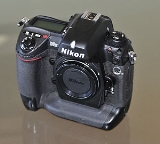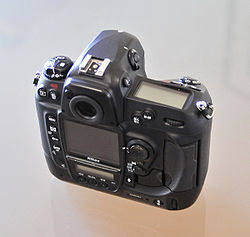
Nikon D2H
Encyclopedia
The Nikon D2H is a professional-grade digital single-lens reflex camera
introduced by Nikon Corporation on July 22, 2003. It uses Nikon's own JFET
-LBCAST
sensor with a 4.1 megapixel resolution, and is optimised for sports and action shooting that require a high frame rate. In 2005, the D2H was replaced by the D2Hs, which added new features derived from the 12 megapixel D2X
digital SLR. The D2Hs was discontinued after the introduction of the D300
and D3
models.
Like most Nikon Digital SLR cameras, it uses a "DX Format
" sensor, which applies a crop factor
compared to 35 mm film
of approximately 1.5×.
ing system, faster subject acquisition and tracking algorithms to the Multi-CAM-2000 Autofocus
module, and expanded both the JPEG and RAW continuous shooting buffer.
Nikon also reported improved noise reduction at high sensor sensitivities. The ASIC
image processing was changed to 12-bit from the original D2H 8-bit. Auto White Balance
was altered with improved low color temperature lighting, mixed ambient, and speedlight
lighting. SYCC color space was added, and Exif compliance was adjusted from Exif 2.2 to Exif 2.21, DCF 2.0, and DPOF.
GPS support and improved wireless support (with WT-2 transmitter for 802.11b/g) were also added. A new LCD screen of the same size but with increased resolution and a higher refresh rate was added to the body. The screen's playback mode now supports 15x zoom instead of the 8x of the D2H, with RGB Histogram.
The menus have been expanded to include an additional 5 languages for a total of 10. Like the D2X, it features a recent settings list, world time function, and modified vertical shooting buttons and CompactFlash card door opening.
The D2Hs features a continuous burst rate of up to 8 frames per second, with a buffer capacity of 50 JPEG files or 40 NEF (Nikon Electric Format- Nikon's proprietary Camera RAW image format) files. The 4.1 megapixel sensor has an ISO sensitivity equivalency of ISO 200–1600, in 1/3, 1/2, and 1 stop increments, as well as Hi-1 and Hi-2 ISO boosts (3200 and 6400 equivalency).
It offers full compatibility with AF-S, VR, DX, D and G type AF-Nikkor lenses, all functions except autofocus and some exposure modes with D-type Manual Focus Nikkors, with AI-P Nikkors all functions except 3D Color Matrix Metering II, 3D Multi-Sensor Balanced Fill-Flash and AF possible.
The D2Hs, like the D2X, offers compatibility with Non-CPU AI Nikkor lenses, which are usable in aperture-priority or manual exposure mode with Matrix-Metering, Center-Weighted and Spot metering available.
 Although the D2Hs has been considered by some to be obsolete from its very introduction due to its relatively low 4.1 megapixel resolution, the D2Hs has a reputation for extremely high image quality and excellent detail rendition.
Although the D2Hs has been considered by some to be obsolete from its very introduction due to its relatively low 4.1 megapixel resolution, the D2Hs has a reputation for extremely high image quality and excellent detail rendition.
The D2Hs offers a noticeable improvement over the D2H in overall image quality and many users have reported that color rendition is improved in JPEG files (raw is the same), while the camera manages to offer a great improvement in noise at high sensitivities versus the D2H
(IR) filter, causing certain dark-colored fabrics to take on a slight magenta color cast. Skin tones may also appear slightly ruddy. Use of a No. 486 digital UV/IR blocking filter can help resolve the problem with lenses that are at least 50 mm or longer. Lenses shorter than 50 mm are not recommended for use with a No. 486 filter due to a tendency for the corners of the image to take on a cyan color cast.
Digital single-lens reflex camera
Most digital single-lens reflex cameras are digital cameras that use a mechanical mirror system and pentaprism to direct light from the lens to an optical viewfinder on the back of the camera....
introduced by Nikon Corporation on July 22, 2003. It uses Nikon's own JFET
JFET
The junction gate field-effect transistor is the simplest type of field-effect transistor. It can be used as an electronically-controlled switch or as a voltage-controlled resistance. Electric charge flows through a semiconducting channel between "source" and "drain" terminals...
-LBCAST
LBCAST
LBCAST is a type of photo sensor which the manufacturer claims is simpler and thus smaller and faster than CMOS sensors...
sensor with a 4.1 megapixel resolution, and is optimised for sports and action shooting that require a high frame rate. In 2005, the D2H was replaced by the D2Hs, which added new features derived from the 12 megapixel D2X
Nikon D2X
The Nikon D2X is a 12.4 megapixel professional digital single-lens reflex camera that Nikon Corporation announced on September 16, 2004. The D2X was the high resolution flagship in Nikon's DSLR line until June 2006 when it was supplanted by the D2Xs and later on by two new flagship cameras: the...
digital SLR. The D2Hs was discontinued after the introduction of the D300
Nikon D300
The Nikon D300 is a 12.3-megapixel professional DX format digital single-lens reflex camera that Nikon Corporation announced on 23 August 2007 along with the Nikon D3 FX format camera. It replaced the D200 as Nikon's DX format flagship DSLR...
and D3
Nikon D3
The Nikon D3 is a 12.1 megapixel professional grade full frame digital single lens reflex camera announced by the Nikon Corporation on 23 August 2007 along with the Nikon D300 DX format camera. The D3, along with the Nikon D3X, was a flagship model in Nikon's line of DSLRs, superseding the D2Hs...
models.
Like most Nikon Digital SLR cameras, it uses a "DX Format
Nikon DX format
The Nikon DX format is an alternative name used by Nikon corporation for APS-C image sensor format being approximately 24×16 mm. Its dimensions are about 2/3 those of the 35mm film format . The format was created by Nikon for its digital SLR cameras, many of which are equipped with DX-sized...
" sensor, which applies a crop factor
Crop factor
In digital photography, a crop factor is related to the ratio of the dimensions of a camera's imaging area compared to a reference format; most often, this term is applied to digital cameras, relative to 35 mm film format as a reference. In the case of digital cameras, the imaging device would be a...
compared to 35 mm film
135 film
The term 135 was introduced by Kodak in 1934 as a designation for cartridge film wide, specifically for still photography. It quickly grew in popularity, surpassing 120 film by the late 1960s to become the most popular photographic film format...
of approximately 1.5×.
D2Hs
The D2Hs was announced on February 16, 2005, adding several improvements to the D2H design, although with the same sensor and body. Nikon added an improved light meterLight meter
A light meter is a device used to measure the amount of light. In photography, a light meter is often used to determine the proper exposure for a photograph...
ing system, faster subject acquisition and tracking algorithms to the Multi-CAM-2000 Autofocus
Autofocus
An autofocus optical system uses a sensor, a control system and a motor to focus fully automatic or on a manually selected point or area. An electronic rangefinder has a display instead of the motor; the adjustment of the optical system has to be done manually until indication...
module, and expanded both the JPEG and RAW continuous shooting buffer.
Nikon also reported improved noise reduction at high sensor sensitivities. The ASIC
Application-specific integrated circuit
An application-specific integrated circuit is an integrated circuit customized for a particular use, rather than intended for general-purpose use. For example, a chip designed solely to run a cell phone is an ASIC...
image processing was changed to 12-bit from the original D2H 8-bit. Auto White Balance
Color temperature
Color temperature is a characteristic of visible light that has important applications in lighting, photography, videography, publishing, manufacturing, astrophysics, and other fields. The color temperature of a light source is the temperature of an ideal black-body radiator that radiates light of...
was altered with improved low color temperature lighting, mixed ambient, and speedlight
Speedlight
Speedlight is the brand name used by Nikon Corporation for their photographic flash units, used since the company's introduction of strobe flashes in the 1960s. Nikon's standalone Speedlights have the SB- prefix as part of their model designation...
lighting. SYCC color space was added, and Exif compliance was adjusted from Exif 2.2 to Exif 2.21, DCF 2.0, and DPOF.
GPS support and improved wireless support (with WT-2 transmitter for 802.11b/g) were also added. A new LCD screen of the same size but with increased resolution and a higher refresh rate was added to the body. The screen's playback mode now supports 15x zoom instead of the 8x of the D2H, with RGB Histogram.
The menus have been expanded to include an additional 5 languages for a total of 10. Like the D2X, it features a recent settings list, world time function, and modified vertical shooting buttons and CompactFlash card door opening.
The D2Hs features a continuous burst rate of up to 8 frames per second, with a buffer capacity of 50 JPEG files or 40 NEF (Nikon Electric Format- Nikon's proprietary Camera RAW image format) files. The 4.1 megapixel sensor has an ISO sensitivity equivalency of ISO 200–1600, in 1/3, 1/2, and 1 stop increments, as well as Hi-1 and Hi-2 ISO boosts (3200 and 6400 equivalency).
It offers full compatibility with AF-S, VR, DX, D and G type AF-Nikkor lenses, all functions except autofocus and some exposure modes with D-type Manual Focus Nikkors, with AI-P Nikkors all functions except 3D Color Matrix Metering II, 3D Multi-Sensor Balanced Fill-Flash and AF possible.
The D2Hs, like the D2X, offers compatibility with Non-CPU AI Nikkor lenses, which are usable in aperture-priority or manual exposure mode with Matrix-Metering, Center-Weighted and Spot metering available.
Reaction to Improvements over the D2H

The D2Hs offers a noticeable improvement over the D2H in overall image quality and many users have reported that color rendition is improved in JPEG files (raw is the same), while the camera manages to offer a great improvement in noise at high sensitivities versus the D2H
Infrared contamination
The D2H series has a relatively weak infraredInfrared
Infrared light is electromagnetic radiation with a wavelength longer than that of visible light, measured from the nominal edge of visible red light at 0.74 micrometres , and extending conventionally to 300 µm...
(IR) filter, causing certain dark-colored fabrics to take on a slight magenta color cast. Skin tones may also appear slightly ruddy. Use of a No. 486 digital UV/IR blocking filter can help resolve the problem with lenses that are at least 50 mm or longer. Lenses shorter than 50 mm are not recommended for use with a No. 486 filter due to a tendency for the corners of the image to take on a cyan color cast.

